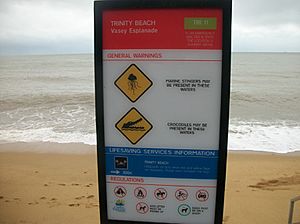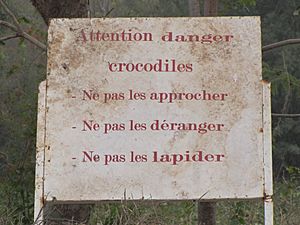Crocodile attack facts for kids
Crocodiles are amazing reptiles, but some can be dangerous to humans. When we talk about "crocodile attacks," we mean when these powerful animals hurt people. This usually happens in places where many large crocodiles live close to human communities. It's important to remember that out of 23 different types of crocodiles and their relatives (called crocodilians), only about six are considered truly dangerous to adult humans.
Usually, only crocodiles that are about 2 meters (6.5 feet) long or more are a serious threat. Smaller crocodiles are generally not big enough to kill a human. However, even a small crocodile can give a very painful bite that might need stitches! Also, a very young child could be the same size as the prey that smaller crocodiles usually hunt.
Contents
Dangerous Crocodiles Around the World
Some types of crocodiles are more well-known for attacking humans than others. It's good to know which ones are considered the most dangerous.
Nile Crocodiles
The Nile crocodile lives in many parts of Africa, south of the Sahara Desert. These crocodiles are very powerful hunters. Sadly, hundreds of deadly attacks happen each year because of Nile crocodiles.
Saltwater Crocodiles
The saltwater crocodile is the largest living reptile. It lives in places like Southeast Asia, Australia, New Guinea, Borneo, and the Solomon Islands. These "salties" are also very dangerous, and attacks happen often in their habitats.
Mugger Crocodiles
In India, the mugger crocodile is another very dangerous species. They are responsible for many attacks on people every year.
Other Crocodilians
- The American crocodile lives in parts of North and South America. They are generally less aggressive than Nile or saltwater crocodiles. There have only been a few reports of them fatally attacking humans, and these cases are not always proven.
- The black caiman lives in the Amazon basin. They are also responsible for several recorded human deaths each year in their region.
- The American alligator lives mostly in the southeastern United States, especially Florida. While they can be dangerous, most attacks happen when people feed them or get too close.
Images for kids
-
A makeshift barrier in Uganda to help reduce the risk of Nile crocodile attacks.





